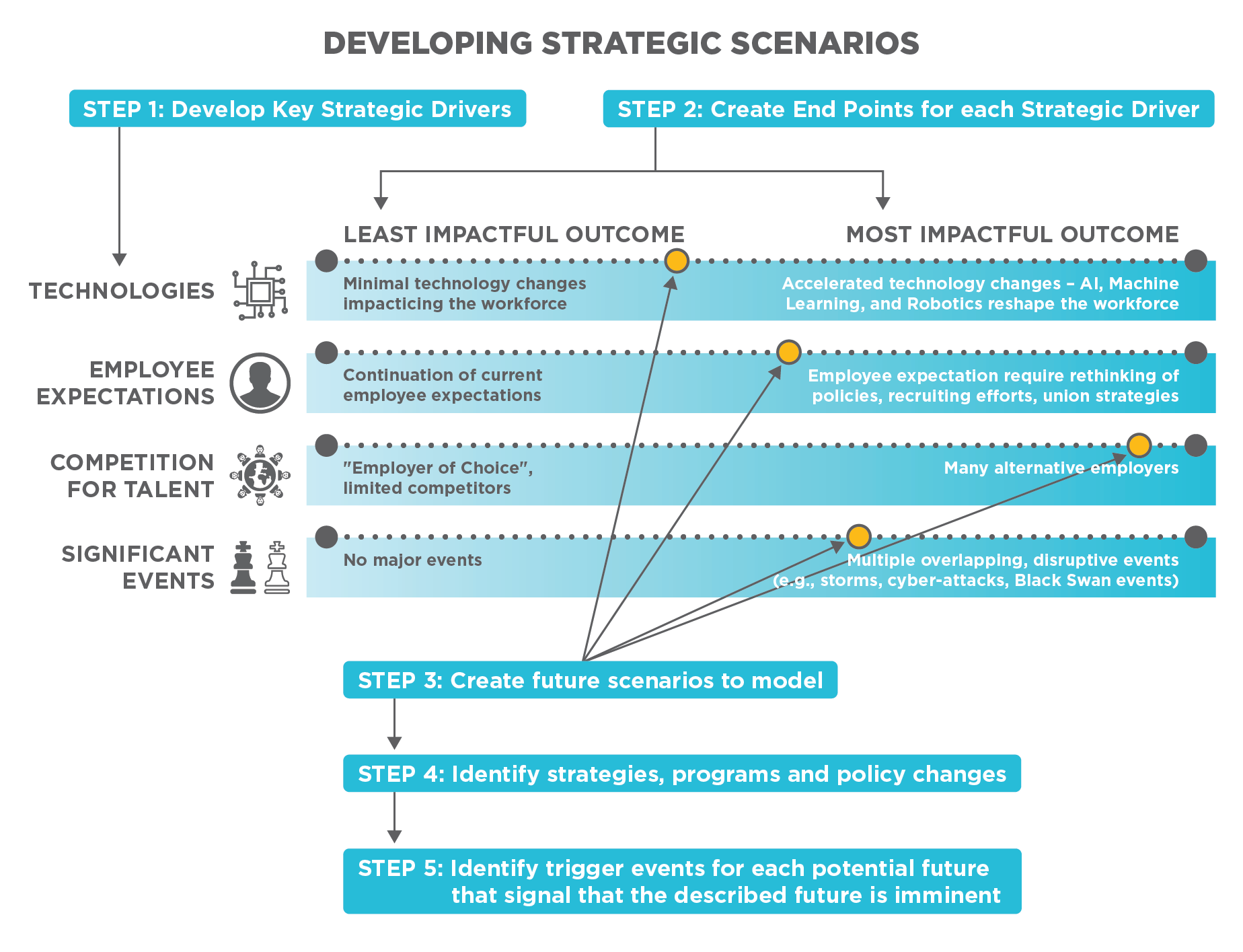
Workforce safety and productivity challenges. The need for frequent, transparent, and consistent communications. New leadership requirements, including management of remote teams. New compliance requirements triggered by the Family First Coronavirus Response Act. The pandemic has created unprecedented business challenges that arose at a pace that few anticipated. Even those with detailed business continuity plans found that the nature of this event (e.g., shelter-in-place orders, uncertainty of duration, immediate impacts to commercial and industrial client work) stretched plans beyond their design.
As utility leaders take action to address immediate and near-term needs, attention is also needed on longer-term workforce strategies. Examples of key planning questions include:
Answering these questions can be daunting, but using a structured approach can help. Scenario planning is a tool that is often used to develop corporate strategies under a variety of potential futures. This approach can be adapted to focus on planning for important aspects of workforce strategy.

The five steps to scenario-based workforce strategy are:
Identify the key factors driving strategy that could potentially affect your workforce as part of the “new normal.” These factors might include:
As an example, let’s evaluate a potential strategic driver for this new normal: employee expectations (e.g., workplace safety, remote work policies and programs, time off policies).
For each strategic factor, determine and describe the two ends of the spectrum for future situations—the least risky outcome (e.g., workforce needs remain the same) and the most extreme outcome (e.g., most significant changes require a full reboot of workforce strategy).
Continuing with our example of employee expectations, let’s now define the two end points:
Looking across the strategic drivers and the potential spectrum of outcomes, establish a set of future scenarios that might emerge in the new normal environment. Usually, these potential scenarios will fall somewhere along the spectrum of future situations. As a group exercise, you may even “vote” on where along the spectrum your future is likely to be (e.g., leaning toward the lowest-risk end, leaning toward the extreme end, or perhaps, somewhere in the middle). Scenarios may reflect the worst-case, but less likely future for a particular driver, or they may represent a more likely, but less impactful future. In more advanced-planning exercises, scenarios are built across multiple drivers, but for initial planning, we recommend that teams focus on scenarios that are impacted by a single driver.
In our example, a particular scenario might be one where employees’ expectations are at the upper end of the spectrum. Unions and individual employees and applicants are expecting changes to the work environment, flexible work policies, aggressive monitoring of employee wellness, and increased workplace sanitation standards.
In this step, create strategies that would address each of the issues, challenges, or opportunities presented for each scenario. In developing these strategies, consider “no regrets” actions that will benefit any scenario.
For our example, strategies might include creating a tiered remote work policy that provides varying levels of flexibility when external events dictate or creating a crowd-sourced tracker of employee wellness that would alert management when employee concerns about workplace safety are escalating. A no regrets action may be enhancing work tools and technology that will be beneficial in either a low-risk or extreme scenario.
These triggers will serve as the “canary in the coal mine” that the strategies or policy changes identified for that future should be implemented.
Our example scenario might have trigger events, such as a rise in employee complaints or grievances, an increase in employee regrettable departures (e.g., looking for better conditions/more flexibility), or candidate feedback around workplace policies from recruiting events.
This structured approach works well as a group session attended by leaders representing delivery operations, generation, workforce planning, and HR business partners. By focusing on possible scenarios, participants anticipate the challenges, opportunities, and business decisions that accompany each potential future and document actions that mitigate negative impacts or take advantage of opportunities.
COVID-19 has tested the preparedness of utilities and, in some cases, created renewed awareness of the value of workforce strategy. By adapting proven scenario planning techniques to focus on workforce needs, utilities can improve their ability to respond quickly and confidently to future events.
ScottMadden has guided many leaders through this strategic planning process, and we can help you and your team think through workforce strategies and other challenges presented by COVID-19. We are all working through this one day at a time. Let us know if we can help you!
We know energy from the ground up. Since 1983, we have served as energy consultants for hundreds of utilities, large and small, including all of the top 20. We focus on Transmission & Distribution, the Grid Edge, Generation, Energy Markets, Rates & Regulation, Enterprise Sustainability, and Corporate Services. Our broad, deep utility expertise is not theoretical—it is experience based. We have helped our clients develop and implement strategies, improve critical operations, reorganize departments and entire companies, and implement myriad initiatives.
ScottMadden is the management consulting firm that does what it takes to get it done right. We consult in two main areas—Energy and Corporate & Shared Services. We deliver a broad array of consulting services ranging from strategic planning through implementation across many industries, business units, and functions. To learn more, visit www.scottmadden.com | Twitter | Facebook | LinkedIn.
Kim Davenport is a partner with ScottMadden and John Gray is a director.
View MoreSussex Economic Advisors is now part of ScottMadden. We invite you to learn more about our expanded firm. Please use the Contact Us form to request additional information.